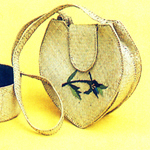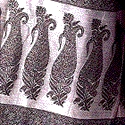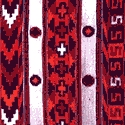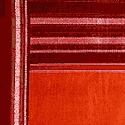Kora/Sedge Grass Mat Weaving of Kerala,
Kora grass or Sedge grass yielding natural fibres have been in use since decades in Kerala to produce array of products. Extremely delicate, the mats made with kora / sedge grass are highly prized and valued; Kora grass grows abundantly along the banks of the rivers and in marshy areas. The process of creating the mat is complex and painstaking. In its original form the grass is green in colour and normally grows to a height of 3-4 feet. The grass for the mats is cut very finely while it is still green. The grass is collected in the months of September/ October and February/March. The tools used are basic and include Knife, Machete, Wooden mallets, Floor loom, Thandu - bamboo rollers, Pegs, Shuttle, Scissors Wooden tripod Polishing stones and long hooded needle. The inside white pith (choi) of the stem is removed with a sharp-edged knife while the outer part of the stem is used for weaving. The counts of the mat depend on how many strips the grass is cut into; the greater the number of strips from each stem the higher the count. The strips of grass are then dried in the hot sun. They are, however, never exposed to humidity, as they tend to turn black with the exposure. When the dried grass strips turn a yellowish greenish colour they are boiled in a pot of water and then dried again. The dried grass is made up into bundles and then soaked in running water. These bundles are weighed down with stones at both ends; they are then made to float in running streams of clean water. The weight of the stone is so adjusted that the grass remains just below the surface of the water. The grass is normally kept under water for three days, but sometimes it is kept under water for up to seven days, ensuring a very fine count. This wetting causes the grass to swell up to three times its original size. It is then dried again in the sun. The weaving is done on a floor loom. The process is slow and follows a basket weave pattern. The weft (or the grass) covers the warp entirely and the pattern formed has an interesting striped effect of its own. Once the weavings is complete, the mat is dried in the sun for a short while. It is then finished with a polishing stone. Traditionally only two colours --- red and black --- were used on the mats. For dyeing the grass both natural and chemical dyes are used. The natural dye is taken from sappon or Brazil wood and is fixed with an alum mordant. With the introduction of chemical dyes a wide range of colours have been introduced into the mats. The warp on which the grass mats are woven was traditionally made of elephant aloe fibre. However, the weavers have now started using cotton or silk yarn as a substitute in the warp while weaving. The warp is made by the men while the weaving is done by the women. The designs on the mats are constantly evolving, changing from simple stripes to reproductions of monuments, animals, plants, and trees. Kora mats are extremely pliable and can be easily folded. The products produced include sleeping mats, prayer table mats, floor matting, door mats, window and wall mats, letter boxes, bags, runners and baskets. These products have a potential export market which still stays untapped. Other than kora grass, coconut husks and Palmyra leaves are some more traditional sources of naturally yielding fibres used to produce products. The products are made in the areas where the raw material is easily accessible like Chittur and Malmapuza in Pallakad District; Kilimangalam in Thrissur district.
Kora grass or Sedge grass yielding natural fibres have been in use since decades in Kerala to produce array of products. Extremely delicate, the mats made with kora / sedge grass are highly prized and valued; Kora grass grows abundantly along the banks of the rivers and in marshy areas. The process of creating the mat is complex and painstaking. In its original form the grass is green in colour and normally grows to a height of 3-4 feet. The grass for the mats is cut very finely while it is still green. The grass is collected in the months of September/ October and February/March. The tools used are basic and include Knife, Machete, Wooden mallets, Floor loom, Thandu - bamboo rollers, Pegs, Shuttle, Scissors Wooden tripod Polishing stones and long hooded needle. The inside white pith (choi) of the stem is removed with a sharp-edged knife while the outer part of the stem is used for weaving. The counts of the mat depend on how many strips the grass is cut into; the greater the number of strips from each stem the higher the count. The strips of grass are then dried in the hot sun. They are, however, never exposed to humidity, as they tend to turn black with the exposure. When the dried grass strips turn a yellowish greenish colour they are boiled in a pot of water and then dried again. The dried grass is made up into bundles and then soaked in running water. These bundles are weighed down with stones at both ends; they are then made to float in running streams of clean water. The weight of the stone is so adjusted that the grass remains just below the surface of the water. The grass is normally kept under water for three days, but sometimes it is kept under water for up to seven days, ensuring a very fine count. This wetting causes the grass to swell up to three times its original size. It is then dried again in the sun. The weaving is done on a floor loom. The process is slow and follows a basket weave pattern. The weft (or the grass) covers the warp entirely and the pattern formed has an interesting striped effect of its own. Once the weavings is complete, the mat is dried in the sun for a short while. It is then finished with a polishing stone. Traditionally only two colours --- red and black --- were used on the mats. For dyeing the grass both natural and chemical dyes are used. The natural dye is taken from sappon or Brazil wood and is fixed with an alum mordant. With the introduction of chemical dyes a wide range of colours have been introduced into the mats. The warp on which the grass mats are woven was traditionally made of elephant aloe fibre. However, the weavers have now started using cotton or silk yarn as a substitute in the warp while weaving. The warp is made by the men while the weaving is done by the women. The designs on the mats are constantly evolving, changing from simple stripes to reproductions of monuments, animals, plants, and trees. Kora mats are extremely pliable and can be easily folded. The products produced include sleeping mats, prayer table mats, floor matting, door mats, window and wall mats, letter boxes, bags, runners and baskets. These products have a potential export market which still stays untapped. Other than kora grass, coconut husks and Palmyra leaves are some more traditional sources of naturally yielding fibres used to produce products. The products are made in the areas where the raw material is easily accessible like Chittur and Malmapuza in Pallakad District; Kilimangalam in Thrissur district.
Kornadu Sari weaving of Karnataka,
These saris are a mix of cotton and silk and are woven with a blue cotton yarn and a silk yarn in several colours other than blue. The border motifs are varied and the body of the sari has checked or striped patterns.
These saris are a mix of cotton and silk and are woven with a blue cotton yarn and a silk yarn in several colours other than blue. The border motifs are varied and the body of the sari has checked or striped patterns.
Korvai Dhoti Weaving of Tamil Nadu,
Korvai means the weaving of solid border with the use of three shuttles. The two side shuttles carry colours for the border which include the same material and colours as the border warp. The central shuttle carries the material and colour of the body of the dhoti or sari. The borders are woven with a non-continuous weft and interlocked together, creating solid, colour borders. This complicated technique of weaving is used both for cottons and silks. The technique of weaving involves the shuttle on the right being thrown by hand through the shed created in the border; the thread is intertwined with the weft of the body and placed on the woven section. The second shuttle is thrown right across to the other border where the thread of the third shuttle is intertwined with the body weft and thrown across the border. The shed is closed and the process is repeated.
Korvai means the weaving of solid border with the use of three shuttles. The two side shuttles carry colours for the border which include the same material and colours as the border warp. The central shuttle carries the material and colour of the body of the dhoti or sari. The borders are woven with a non-continuous weft and interlocked together, creating solid, colour borders. This complicated technique of weaving is used both for cottons and silks. The technique of weaving involves the shuttle on the right being thrown by hand through the shed created in the border; the thread is intertwined with the weft of the body and placed on the woven section. The second shuttle is thrown right across to the other border where the thread of the third shuttle is intertwined with the body weft and thrown across the border. The shed is closed and the process is repeated.
Kota Doria Weaving of Rajasthan,
Doria (striped) fabrics in narrow widths used for turbans were woven in Kota in the past. Today, this activity is practiced by the weavers of the Hadoti region (Bundi, Kota and Baran districts of Rajasthan). Kota is now famous for its “Kota Doria Saree”, sometimes known as “Kota Masuria Saree”. The saree is produced by using cotton and mulberry raw silk yarns for the base fabric with gold and silver zari (fine metal threads) yarns in the extra warp and extra weft for designing. The cotton yarn provides strength and suppleness while the fine raw silk gives the fabric a transparent and delicate appearance. The light as air Kota Doria weave has been perfected for the long hot dry months of Rajasthan. The lightness of the weave, its transparent and delicate texture and its soft feel making it perfect wear, whether draped as a sari or tied on the head as a turban. The name of the weave derives from the location of the weavers in the town of Kota in Rajasthan; while Doria refers to the fine woven lines and checks on the textile created by altering the density of the yarn, patterning the textile without adding to its weight. The self patterning on a Kota Doria sari is called khat, and there can be over 400 of these micro-check khats across the width of the fabric. Using metallic zari yarns in gold or silver the weavers add on an element of embellishment considered necessary for an Indian wardrobe. Kota Doria is woven in several villages located in Kota, with the oldest and largest concentration of weavers in the village of Kaithun, about 15 kms from the town of Kota. Woven by the community of Ansari weavers there are records of the antiquity of the tradition to the time when weavers from Mysore in the south of India were brought to Kota by the ruling Prince, Rao Kishore Singh (1684 - 1695). The weavers settled in Kaithun and gradually grew in number as they inter-married and the craft of weaving Kota Doria spread from a few families to several households across to villages in the vicinity.
Doria (striped) fabrics in narrow widths used for turbans were woven in Kota in the past. Today, this activity is practiced by the weavers of the Hadoti region (Bundi, Kota and Baran districts of Rajasthan). Kota is now famous for its “Kota Doria Saree”, sometimes known as “Kota Masuria Saree”. The saree is produced by using cotton and mulberry raw silk yarns for the base fabric with gold and silver zari (fine metal threads) yarns in the extra warp and extra weft for designing. The cotton yarn provides strength and suppleness while the fine raw silk gives the fabric a transparent and delicate appearance. The light as air Kota Doria weave has been perfected for the long hot dry months of Rajasthan. The lightness of the weave, its transparent and delicate texture and its soft feel making it perfect wear, whether draped as a sari or tied on the head as a turban. The name of the weave derives from the location of the weavers in the town of Kota in Rajasthan; while Doria refers to the fine woven lines and checks on the textile created by altering the density of the yarn, patterning the textile without adding to its weight. The self patterning on a Kota Doria sari is called khat, and there can be over 400 of these micro-check khats across the width of the fabric. Using metallic zari yarns in gold or silver the weavers add on an element of embellishment considered necessary for an Indian wardrobe. Kota Doria is woven in several villages located in Kota, with the oldest and largest concentration of weavers in the village of Kaithun, about 15 kms from the town of Kota. Woven by the community of Ansari weavers there are records of the antiquity of the tradition to the time when weavers from Mysore in the south of India were brought to Kota by the ruling Prince, Rao Kishore Singh (1684 - 1695). The weavers settled in Kaithun and gradually grew in number as they inter-married and the craft of weaving Kota Doria spread from a few families to several households across to villages in the vicinity.
Kovai Kora Cotton Sari Weaving of Tamil Nadu,
Saris of very fine cotton are woven widely in Coimbatore district. The kora cotton sari has a kora silk warp and a cotton weft yarn. The sari has a self-designed jacquard all over. Kovai Cora Cotton or Kovai Kora Cotton is woven in the Coimbatore region of Tamil Nadu. Kovai Kora Cotton is made from a blend of silk and cotton. A superior quality cotton yarn is used in the weft whereas mulberry silk yarn is used in the warp to weave the fabric. The fabrics developed have brightly coloured border designs. They are woven on fly shuttle raised pit looms fitted with the jacquard mechanism.
Saris of very fine cotton are woven widely in Coimbatore district. The kora cotton sari has a kora silk warp and a cotton weft yarn. The sari has a self-designed jacquard all over. Kovai Cora Cotton or Kovai Kora Cotton is woven in the Coimbatore region of Tamil Nadu. Kovai Kora Cotton is made from a blend of silk and cotton. A superior quality cotton yarn is used in the weft whereas mulberry silk yarn is used in the warp to weave the fabric. The fabrics developed have brightly coloured border designs. They are woven on fly shuttle raised pit looms fitted with the jacquard mechanism.
Kullu Shawls And Woollen Material of Himachal Pradesh,
The wool for the Kullu shawls is locally sourced from sheep and goat - the byangi and deshkar, the pashmina wool is sourced from Tibet, while Merino wool is sourced in Ludhiana, Punjab. Weaving and spinning of shawls and other wool lengths is a critical part of the home and small scale industry of Himachal in the individual grey, off-white, fawn or brown shades of natural wools. With the chequered styles and lined styles of shawls also popular. While the most well known product woven is the Kullu shawl with its distinct weft-faced tapestry borders in multi-coloured geometrical forms and its combed twill-weave body. The shawls worn by the women are called pattu and those used by the men are called chandru. Tweeds and other woven lengths is also an important product. While blankets - dhoru and Loi, mufflers, borders, caps are also produced.
The wool for the Kullu shawls is locally sourced from sheep and goat - the byangi and deshkar, the pashmina wool is sourced from Tibet, while Merino wool is sourced in Ludhiana, Punjab. Weaving and spinning of shawls and other wool lengths is a critical part of the home and small scale industry of Himachal in the individual grey, off-white, fawn or brown shades of natural wools. With the chequered styles and lined styles of shawls also popular. While the most well known product woven is the Kullu shawl with its distinct weft-faced tapestry borders in multi-coloured geometrical forms and its combed twill-weave body. The shawls worn by the women are called pattu and those used by the men are called chandru. Tweeds and other woven lengths is also an important product. While blankets - dhoru and Loi, mufflers, borders, caps are also produced.
Kunbi Sari Weaving of Goa,
The Kunbi sari, once woven in Goa, is an important clothing icon for the state. Worn by the Kunbi tribe that settled on the ancient Konkan coast, the sari was lost to history due to caste implications and the lack of weaving in Goa. Dyed in red, blue or black, the sari is woven in checks with a double row of dobby design at the border and draped with a single 'dentli' knot at the shoulder. The red saris were used for celebrations and the blue/lilac sari was worn by young widows. In 2010, designer Wendell Rodricks revived the Kunbi sari in his minimalist style using natural dyes and weaving the sari in Goa with PoonamPandit. After almost a century of the sari not woven in the state, the Kunbi sari revival was widely acclaimed at India Fashion Week among fashionistas and cotton sari lovers. Displayed is the original Kunbi sari and the Wendell Rodricks version of the sari. See the Kunbi culture with dance performances on 7-8 Jan 2017 at the Adivasi SangatnaQuepem festival organised by Advocate John Fernandes at XeldemPanchayat ground in Quepem
The Kunbi sari, once woven in Goa, is an important clothing icon for the state. Worn by the Kunbi tribe that settled on the ancient Konkan coast, the sari was lost to history due to caste implications and the lack of weaving in Goa. Dyed in red, blue or black, the sari is woven in checks with a double row of dobby design at the border and draped with a single 'dentli' knot at the shoulder. The red saris were used for celebrations and the blue/lilac sari was worn by young widows. In 2010, designer Wendell Rodricks revived the Kunbi sari in his minimalist style using natural dyes and weaving the sari in Goa with PoonamPandit. After almost a century of the sari not woven in the state, the Kunbi sari revival was widely acclaimed at India Fashion Week among fashionistas and cotton sari lovers. Displayed is the original Kunbi sari and the Wendell Rodricks version of the sari. See the Kunbi culture with dance performances on 7-8 Jan 2017 at the Adivasi SangatnaQuepem festival organised by Advocate John Fernandes at XeldemPanchayat ground in Quepem
Kurainadu and Kodambakkam Sari Weaving of Tamil Nadu,
Kurainadu and Kodambakkam saris made in a cotton and silk mixture, often with a cotton body and a mixed silk and cotton border. The saris have broad borders and pallus, and the designs are geometric or floral. Some typical motifs are rudraaksham/big seed, flowers, chalangai/bells, vanki/armlet, panirchombu/rose-water pot, and metti/toe ring. A variety of checks are also used as designs.
Kurainadu and Kodambakkam saris made in a cotton and silk mixture, often with a cotton body and a mixed silk and cotton border. The saris have broad borders and pallus, and the designs are geometric or floral. Some typical motifs are rudraaksham/big seed, flowers, chalangai/bells, vanki/armlet, panirchombu/rose-water pot, and metti/toe ring. A variety of checks are also used as designs.
Kuthampully Dhoties and Set Mundu of Kerala,
Kuthampully village in the Thrissur district of Kerala is well known for its handloom weaving of Kerala’s traditional attire. The origin of the Kuthampully Dhoties and Set Mundu goes back to the end of the 18th century. They are woven with fine cotton and pure zari. However, due to the high price of pure zari, imitation zari is frequently used instead. The base fabric is generally off-white or non-bleached.
Kuthampully village in the Thrissur district of Kerala is well known for its handloom weaving of Kerala’s traditional attire. The origin of the Kuthampully Dhoties and Set Mundu goes back to the end of the 18th century. They are woven with fine cotton and pure zari. However, due to the high price of pure zari, imitation zari is frequently used instead. The base fabric is generally off-white or non-bleached.







